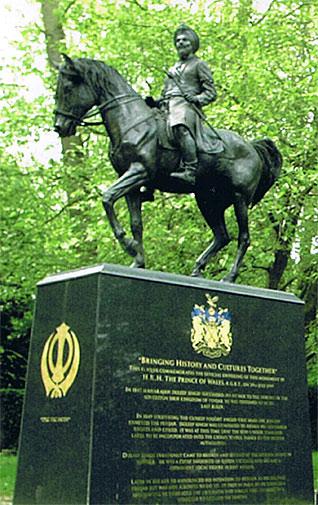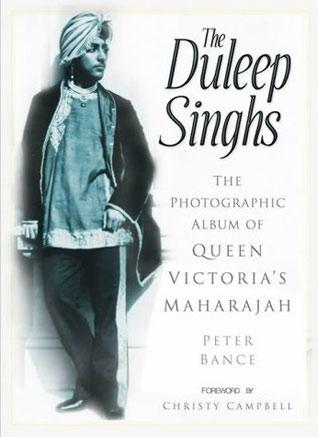Columnists
The Duleep Singhs: The Photograph Album of Queen Victoria's Maharajah
Reviewed by Laurie Bolger
THE DULEEP SINGHS: THE PHOTOGRAPH ALBUM OF QUEEN VICTORIA'S MAHARAJAH
by Peter Bance. Sutton Publishing Ltd., U.K., 2004.
160 pages. Price: 18.99 pounds
This profusely illustrated work contains over 150 photographs of Duleep Singh and his family, many of them previously unpublished. The book's Foreword, by Christy Campbell, interestingly notes that Duleep Singh was born in 1838, at the very inception of photography, and that a "calotype" taken of him at the age of ten was one of the very first photographs made outside Europe.
The author, also known under his Sikh name of Bhupinder Singh Bance, is an independent researcher specializing in Sikh history, and an authority on the Duleep Singh family.
The earlier portions of this book of 11 chapters revolve around Duleep Singh himself. Bance details his ancestry and earliest years as the seventh son of Maharajah Ranjit Singh, the "Lion of the Punjab," and his youngest wife, Maharani Jind Kaur. After events subsequent to the death of his father, he was proclaimed Maharajah at the tender age of five.
In 1847, following defeat in the First Anglo-Sikh War, he was torn from his mother, who was ignominously thrown into prison. By then a ward of the British government, he was deposed upon the annexation of the Punjab after the Second Anglo-Sikh War, two years later. Under his guardian's tutelage, Christian baptism followed. In 1854, he was taken to England, where he was immediately adopted as a special favorite of Queen Victoria, who treated him virtually as her adopted son. Without delay, he was swept into the highest social circles of British nobility, where Bance characterizes him as "the ideal party accessory."
We then begin to witness Duleep Singh's amazing transformation. Images of an exotic youth in a bejeweled turban and artfully draped silken robes give way to those of a country squire with short, thinning hair, in frockcoat and cravat or jaunty sporting tweeds. It is no wonder that his ailing mother, upon their reunion in India after 13 years of separation, was shocked at his appearance. Although she died in London scarcely two years later, the Maharani's vivid reminiscences of the former splendor of the Sikh durbar and desire for revenge against the British managed to sow "seeds of discontent" in her son's mind, which would greatly influence his later life.
Bance gracefully waltzes us through ensuing events: a whirlwind courtship -- in the midst of the Maharani's funeral voyage back to India -- with Bamba Muller, a teenaged missionary school student, and high life at the couple's Suffolk estate, where his days of hunting outings were punctuated by notorious Parisian trysts with numerous paramours. As portrayed through an impressive photographic panoply, Elveden Hall soon filled with children. Prince Victor was born in 1866, a year after the loss of a newborn first son, followed over the next decade by Prince Frederick, Princesses Bamba, Catherine and Sophia, and Prince Albert Edward.
As Bance convincingly shows us, Duleep Singh's extravagant lifestyle and the raising of his large brood did not come cheaply. The British government offered to pay his mounting debts on the condition that he agree to sell Elveden Hall after his death, which he refused to do. Instead, he expressed his intention to go to India -- ostensibly to provide his family with a permanent home -- and added his wish to rejoin the Sikh faith.
In the spring of 1886, upon arrival in Aden on his journey eastward, the British arrested him on the grounds that his return to Punjab would pose a danger to the Empire's security. His plans thwarted, he sent his family back to Elveden. After reinitiation as a Sikh, he sailed to Paris, where he renewed a previous affair with Ada Wetheril, a hotel maid.
His firm belief in having been betrayed by the Crown then led him to join a revolutionary group and travel to Russia to seek help from the Tsar in overthrowing the British government. Bance capably documents the strange series of misfortunes, including the demise of two of his closest co-conspirators, which made his mission to liberate India from the Empire's clutches an utter failure.
The last major events of Duleep Singh's life are then recalled: the death of Maharani Bamba, his marriage to Ada, with whom he had two daughters, Princesses Pauline and Ada, his debilitating stroke, and his request to Queen Victoria for a royal pardon, which she granted him, to the great dismay of her ministers. In 1893, several months after the death of Prince Albert Edward, Duleep Singh died at the age of 55. A simple snapshot of his tastefully-carved gravestone in Elveden churchyard completes this section of the book.
The work's later portions focus on the fascinating lives of his six children with Maharani Bamba. Bance shows us the sons morphing from long-haired boys into distinguished British gentlemen, and the lovely daughters blossoming into womanhood, two as ardent Suffragettes. All of them, as well as his two later children, died issueless. The book ends with a very useful two-page family tree, as well as other concluding documentation.
Was Duleep Singh, as Christy Campbell asks in his Foreword, "the anglicized Christian gentleman his mentors so earnestly wished him to be, or the Sikh warrior whose destiny was to regain his stolen kingdom"? The answer to this, and many other questions the reader might have about Duleep Singh, are not fully given in the pages of this work. Being an in-depth analytical biography is not this book's purpose, however. It is, rather, an absorbing visual display of the amazing world of a most colorful personage. Bance admirably succeeds in making Duleep Singh stride gloriously out of the dusty pages of history, on feet of clay perhaps, but unabashedly larger than life.
Conversation about this article
1: Awtar Singh Bahar (Delhi, India), September 06, 2015, 1:21 PM.
History is based on facts available. It is very useful for the new generation and is more important to clear the image and contributions of the Maharaja, considering his difficult and tragic life.





